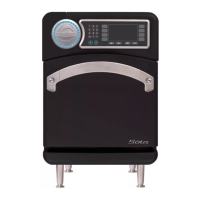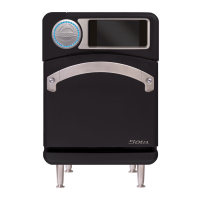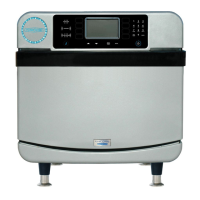24 OVEN SY
STEMS
High-Voltage Transformers
High-voltage transformers are ferro-resonant, which
limits faulty currents and minimizes magnetron power
changes due to input voltage changes. The high-
v
oltage transformer supplies the high v
oltage for the
voltage doubler circuit. They are controlled via the
K8 r
elay
.
Wiring the High-Voltage Transformers
DANGER: Never attempt to wire or
measure the secondary voltage values of the
high-v
oltage transformers. Lethal v
oltage
will be present.
The pr
oper reinstallation of a high-voltage transformer
is critical. U
pon r
emoving a high-voltage transformer,
make sur
e to note where each wire was installed. Refer
to the o
ven schematic (page 45) for wiring detail.
As sho
wn in the schematic, transformers are installed
mirr
or opposite and wired 180
º
out-of-phase. I
t is
essential for longevity that the high-v
oltage trans-
formers r
emain 180
º
out-of-phase.
This can be checked
by placing a volt meter across terminals T1-1 and T2-1
(primar
y voltage).
With the microwave system energized, the volt meter
will read the incoming voltage (different readings for
different electrical installations). If the meter reads 0
V
AC, the high-voltage transformers are most likely
wir
ed in-phase. As a last check, energize the microwave
system and v
erify the voltages between the taps on each
high-voltage transformer.
The wiring issue must be corrected prior to returning
the oven to service, as the voltages must be:
-
NOR
TH AMERICA: 208 VAC between 1 & 2 and
240
betw
een 1 & 3.
- INTERNATIONAL: 230 VAC
NOTE: The orange wire always goes to terminal 3 on
US models.
Testing a Filament or High-Voltage Transformer
DANGER: Never attempt to measure the
secondar
y voltage values of the HV
transformers. Lethal v
oltage will be pr
esent.
1. Disconnect the AC power source and discharge
the high-voltage capacitors.
2.
Disconnect all the wires in question going to and
fr
om the transformer
.
3. Use an ohmmeter to check the impedance of the
primary and secondary winding. Refer to Figure 32,
page 25 to determine if the transformer is OK. If the
resistance is different than the table indicates, replace
the transformer
.
H
igh-Voltage Diodes
The high-voltage diode (Figure 31) is assembled by
connecting sev
eral 1000-1500 volt semi-conductor
diodes in a series to incr
ease the reverse voltage
capability
. In the circuit, the high-voltage diode
conducts to pr
event the filament voltage from
becoming positive, thus as the high-voltage winding
of the transformer goes to a peak of 2400 v
olts, the
high-voltage capacitor is charged to 2400 volts.
When the high-v
oltage winding starts to go toward
negativ
e, the high-voltage diode becomes non-
conducting with the charged high-v
oltage capacitor
in series with the high-voltage winding. When the
transformer gets to its negative peak of -2400 volts,
the voltage applied to the filament is -4500 volts. The
high-voltage diodes are rated at 16 kVDC.
Figure 31: High Voltage Diode

